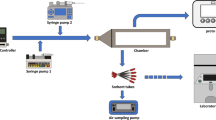Abstract
An analytical methodology using automatic thermal desorption and gas chromatography mass spectrometry analysis was optimized and validated for simultaneous determination of a set of components from three different flame retardant chemical classes: polybrominated diphenyl ethers (PBDEs) (PBDE-28, PBDE-47, PBDE-66, PBDE-85, PBDE-99, PBDE-100), organophosphate flame retardants (PFRs) (tributyl phosphate, tripropyl phosphate, tris(2-chloroethyl)phosphate-, tris(1,3-dichloro-2-propyl) phosphate, tris(2-ethylhexyl) phosphate, triphenyl phosphate, tris(2-chloro-1-methylethyl) phosphate and tricresylphosphate), and “novel” brominated flame retardants (NBFRs) (pentabromotoluene, 2,3,4,5,6-pentabromoethylbenzene, (2,3-dibromopropyl) (2,4,6-tribromophenyl) ether, hexabromobenzene, and 2-ethylhexyl 2,3,4,5-tetrabromobenzoate) in air. The methodology is based on low volume active air sampling of gaseous and particulate air fractions on mixed-bed (polydimethylsiloxane (PDMS)/Tenax TA) sorption tubes. The optimized method provides recoveries >88 %; a limit of detection in the range of 6–25 pg m−3 for PBDEs, 6–171 pg m−3 for PFRs, and 7–41 pg m−3 for NBFRs; a linearity greater than 0.996; and a repeatability of less than 10 % for all studied compounds. The optimized method was compared with a standard method using active air sampling on XAD-2 sorbent material, followed by liquid extraction. On the one hand, the PDMS/Tenax TA method shows comparable results at longer sampling time conditions (e.g., indoor air sampling, personal air sampling). On the other hand, at shorter sampling time conditions (e.g., sampling from emission test chambers), the optimized method detects up to three times higher concentrations and identifies more flame retardant compounds compared to the standard method based on XAD-2 loading.



Similar content being viewed by others
References
ASTM (2011) ASTM D4861-11 Standard practice for sampling and selection of analytical techniques for pesticides and polychlorinated biphenyls in air. D4861-11
Batterman S, Chen TC, Chernyak S, Godwin C (2009) Design and performance evaluation of a medium flow sampler for airborne brominated flame retardants (BFRs). J Environ Monit 11:858–866
Brandsma SH, de Boer J, van Velzen MJM, Leonards PEG (2014) Organophosphorus flame retardants (PFRs) and plasticizers in house and car dust and the influence of electronic equipment. Chemosphere 116:3–9
Cequier E, Ionas AC, Covaci A, Marcé RM, Becher G, Thomsen C (2014) Occurrence of a broad range of legacy and emerging flame retardants in indoor environments in Norway. Environ Sci Technol 48:6827–6835
Covaci A, Harrad S, Abdallah MAE, Ali N, Law RJ, Herzke D, de Wit CA (2011) Novel brominated flame retardants: a review of their analysis, environmental fate and behaviour. Environ Int 37:532–556
Directive 2003/11/EC (2003) of the European Parliament and of the Council of 6 February 2003 amending for the 24th time Council Directive 76/769/EEC relating to restrictions on the marketing and use of certain dangerous substances and preparations (pentabromodiphenyl ether and octabromodiphenyl ether). Off J Eur Union
Ezechiáš M, Covino S, Cajthaml T (2014) Ecotoxicity and biodegradability of new brominated flame retardants: a review. Ecotoxicol Environ Saf 110:153–167
Harrad S, de Wit CA, Abdallah MA-E, Bergh C, Björklund JA, Covaci A, Darnerud PO, de Boer J, Diamond M, Huber S, Leonards P, Mandalakis M, Östman C, Haug LS, Thomsen C, Webster TF (2010) Indoor contamination with hexabromocyclododecanes, polybrominated diphenyl ethers, and perfluoroalkyl compounds: an important exposure pathway for people? Environ Sci Technol 44:3221–3231
Hartmann PC, Bürgi D, Giger W (2004) Organophosphate flame retardants and plasticizers in indoor air. Chemosphere 57:781–787
Higgins CE, Baldwin WH (1961) The thermal decomposition of tributyl phosphate. J Org Chem 26:846–850
ISO (2006) EN ISO 16000–9:2006 Indoor air—Part 9: determination of the emission of volatile organic compounds from building products and furnishing—emission test chamber method (ISO 16000–9:2006)
ISO (2013) ISO 16000–31: Measurement of flame retardants and plasticizers based on organophosphorus compounds—phosphoric acid ester
ISO (2014) ISO 16000–35: Measurement of polybrominated diphenylethers, hexabromocyclododecane and hexabromobenzene
Lazarov B, Swinnen R, Spruyt M, Goelen E, Stranger M, Desmet G, Wauters E (2013) Optimisation steps of an innovative air sampling method for semi volatile organic compounds. Atmos Environ 79:780–786
Sahlström L, Sellström U, de Wit CA (2012) Clean-up method for determination of established and emerging brominated flame retardants in dust. Anal Bioanal Chem 404:459–466
Stockholm Convention (2013) The Stockholm Convention on persistent organic pollutants
van der Veen I, de Boer J (2012) Phosphorus flame retardants: properties, production, environmental occurrence, toxicity and analysis. Chemosphere 88:1119–1153
Wauters E, Van Caeter P, Desmet G, David F, Devos C, Sandra P (2008) Improved accuracy in the determination of polycyclic aromatic hydrocarbons in air using 24-h sampling on a mixed bed followed by thermal desorption capillary gas chromatography-mass spectrometry. J Chromatogr A 1190:286–293
Wei GL, Li DQ, Zhuo MN, Liao YS, Xie ZY, Guo TL, Li JJ, Zhang SY, Liang ZQ (2015) Organophosphorus flame retardants and plasticizers: sources, occurrence, toxicity and human exposure. Environ Pollut 196:29–46
WHO (1997) INCHEM: Enviromental health criteria 192; Flame retardants: a general introduction.1–54
WHO (1998) Inchem: Environmental health criteria 209; Flame retardants: tris(chloropropyl)phosphate and tris(2-chloroethyl)phosphate.1–54
Acknowledgments
The authors would like to acknowledge the financial support of the Environment, Nature and Energy Department of the Flemish Government and the “Inflame” project, funded by the 7th EU Framework Programme (contract 164600) under the Theme People-2010-ITN.
Author information
Authors and Affiliations
Corresponding author
Additional information
Responsible editor: Constantini Samara
Rights and permissions
About this article
Cite this article
Lazarov, B., Swinnen, R., Spruyt, M. et al. Air sampling of flame retardants based on the use of mixed-bed sorption tubes—a validation study. Environ Sci Pollut Res 22, 18221–18229 (2015). https://doi.org/10.1007/s11356-015-5028-z
Received:
Accepted:
Published:
Issue Date:
DOI: https://doi.org/10.1007/s11356-015-5028-z




